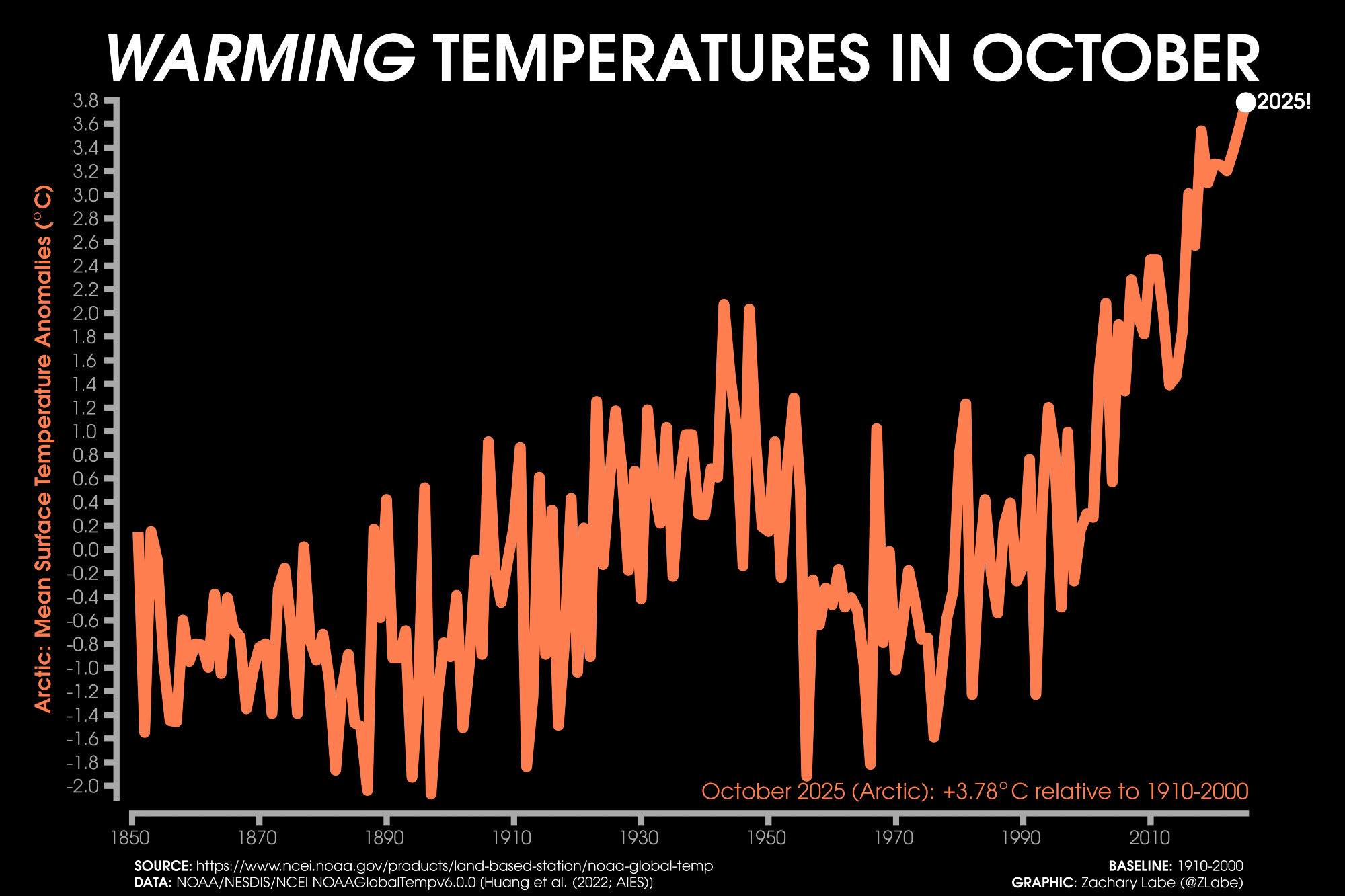By Daniel Brouse and Sidd Mukherjee
November 17, 2025
Q: What is happening with climate change?
A: It is accelerating at an exponential rate -- far faster than the public narrative or old models suggest.
For years, the world was taught to focus on "holding global warming to 1.5°C." But that number has quietly become meaningless. Not only have we likely crossed it already, the real danger is not the temperature itself -- it is the tipping points that crossing that threshold has set in motion. These tipping points have triggered cascading, self-reinforcing feedback loops that are now reshaping Earth's systems with unprecedented speed.
We are not approaching a climate crisis.
We are living inside its accelerating phase.
A global average masks extremes -- the very extremes that dictate human survival.
A 3°C rise in the global mean may sound manageable, but that average blends together oceans, land, and atmosphere. Because oceans absorb ~90% of excess heat and warm far more slowly, they artificially depress the global mean. Meanwhile, the land and atmosphere -- the parts humans inhabit -- are warming far faster.
And nowhere is this clearer than at the poles.

The Arctic is not warming at "four times" the global rate -- it is already warming at more than 20 times the global rate in certain intervals, with localized anomalies exceeding 22°C above historical norms.
This is the engine room of planetary destabilization.
Why does this matter?
For every 1°C increase, the atmosphere can hold 7% more moisture.
At +22°C anomalies, Arctic air can now hold:
22 x 7% = 154% more moisture
This surplus water vapor fuels:
dramatically faster sea level rise
explosive increases in extreme rainfall
larger, faster, more destructive raindrops
intensifying storms, hurricanes, and atmospheric rivers
Momentum of falling rain scales with mass x velocity; velocity and wind damage scale with the square of flow speed; water is 800x denser than air. The result is a nonlinear explosion in destructive power.
An Arctic 20x hotter than average accelerates:
loss of sea ice
albedo collapse
permafrost thaw
methane release
stratospheric moisture injections
atmospheric and oceanic circulation disruption
These amplify global warming on a time-compressed schedule: not centuries, but years to decades
A deep-ocean analysis revealed that even the abyss is warming.
A mere 0.1°C increase in deep-ocean temperature represents a staggering accumulation of heat. If redistributed to land, that heat would equate to ~35°C of warming -- incompatible with human life.
In 2025, the entire Pacific is 1.6°C above average, a six-sigma anomaly -- virtually impossible under natural variability. This is a planetary red alert.
Both are being breached rapidly in localized regions.
In just ten days of July 2025, the U.S. saw:
hundreds of flash floods
multiple "1-in-1,000-year" rainfall events
widespread infrastructure failures across multiple states
This isn't "bad weather."
This is an unstable climate system undergoing phase transition.
Old models assumed gradual thaw over millennia.
Reality:
formerly frozen landscapes now burn year-round
methane and CO2 release is orders of magnitude faster
vast carbon stores are now entering the atmosphere on human timescales
fires may partially "flare" methane into CO2 -- but the overall emissions surge is catastrophic
The real uncertainty isn't if this feedback accelerates warming; it's how fast and how far it will go.
Combustion doesn't only emit CO2-- it forms tropospheric ozone, a potent plant toxin.
Ozone exposure:
reduces plant growth 10--40%
kills sensitive species
weakens forests and crops
makes ecosystems more vulnerable to drought, heat, pests, and fire
Global forests -- the planet's lungs -- have already shifted from carbon sinks to carbon sources.
In our Pennsylvania field site, old-growth trees have lost:
~40% of foliage since 2003
~33% of canopy height
This mirrors global patterns of vegetation decline and reduced carbon uptake.
And ozone harms humans directly:
triggers asthma
increases cardiovascular stress
causes premature death
disproportionately affects children and the elderly
The ozone-wildfire-warming feedback loop is now one of the strongest multipliers of climate instability.
These are not distant projections.
These are real-time runaway feedbacks already visible across ecosystems, oceans, and the atmosphere.
The climate system is now governed by compound nonlinear interactions:
Arctic amplification
ocean heat accumulation
ozone stress
runaway wildfires
permafrost collapse
accelerating hydrological extremes
Each amplifies the others in ways models struggle to capture.
The central scientific question is no longer:
"Will feedback loops accelerate warming?"
It is now:
"How much time is left before cascading feedbacks overwhelm natural and human systems?"
Our research is focused on precisely this:
mapping the speed, scale, and irreversibility of climate feedbacks -- and determining how close Earth is to thresholds that will define the trajectory of human civilization.
* Our probabilistic, ensemble-based climate model — which incorporates complex socio-economic and ecological feedback loops within a dynamic, nonlinear system — projects that global temperatures are becoming unsustainable this century. This far exceeds earlier estimates of a 4°C rise over the next thousand years, highlighting a dramatic acceleration in global warming. We are now entering a phase of compound, cascading collapse, where climate, ecological, and societal systems destabilize through interlinked, self-reinforcing feedback loops.
What Can I Do?
The single most important action you can take to help address the climate crisis is simple: stop burning fossil fuels.